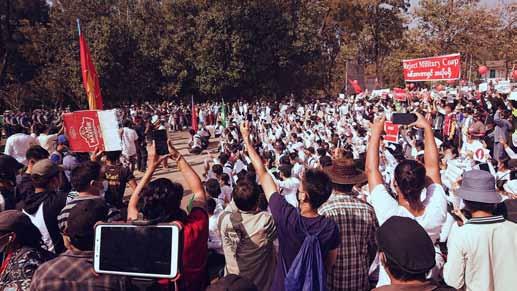
10 minute read
Exploring alternatives – Building grassroots democracy in India
Pallav Das
Democracy is under siege in India. As a consequence of the liberalization of the Indian economy over the last thirty years, the country has become a classic case study in the kind of disasters freemarket fundamentalism is fashioning in the developing world. Whether it is farmers’ suicides because of the failure of genetically modified cotton, the sprouting of unlivable urban ghettos and slums caused by migrations from increasingly unproductive rural areas, the worsening urban pollution, or climate induced environmental calamities; the country is witnessing ever-new forms of depredations on human existence and the consequent curtailing of people’s democratic right to viable living conditions. Still, resistance to this elite model is also emerging with certainty and vigor all over India, and so are the numerous alternative ways of being and living, which are accompanying those movements to challenge the orthodoxy of neoliberalism. Coordinating this large universe is obviously a tough task, yet a new initiative is creating synergy and solidarity among the participants of these initiatives.
Started in 2014, this significant new program is called “Vikalp Sangam” or the “Confluence of Alternatives”. This is the first time an attempt has been made in India to document and coordinate the search for an alternative developmental model, and create opportunities for these grassroots initiatives to network and exchange ideas through regional and issue-based platforms.
In the last seven years, the Vikalp Sangam initiative has established an active website for dissemination of news and views on the “alternatives” issues and practices, and also held eighteen regional and subject specific conclaves to bring thinkers and practitioners together to learn from each other and to further sharpen the debate. These conclaves offer a space for an exchange of ideas and experiences emerging from practice and reflection on a whole range of endeavors: sustainable agriculture and pastoralism, renewable energy, decentralized governance, community health, craft and art revival, multiple sexualities, inclusion of the differently abled, alternative learning and education, communitybased conservation, decentralized water management, urban sustainability, gender and caste equality, and more. But, beyond the act of sharing, however, one of the most important outputs of the Vikalp Sangam process is a conceptual framework of transformative alternatives exploring new possibilities of democratic existence. While focusing on the need for exploring alternative politics this framework has also assimilated a vast universe of experiments being conducted on alternative economies and technologies.
Alternative economies & technologies: These are initiatives that help to create alternatives to the dominant neo-liberal or state-dominated economy and the ‘logic’ of growth, such as localization and decentralization of basic needs towards self-reliance, respect to and support of diverse livelihoods, producer and consumer collectives, local currencies and trade, non-monetized and equal exchange and the gift economy, production based on ecological principles, innovative technologies that respect ecological and cultural integrity, and moving away from GDPlike indicators of well-being to more qualitative, human-scale ones.
Alternative politics: Initiatives and approaches towards people-centered governance and decision-making, including forms of direct democracy or the Gandhian idea of swaraj in urban and rural areas, linkages of these to each other in larger landscapes, re-imagining current political boundaries to make them more compatible with ecological and cultural contiguities, promotion of the non-party political process, methods of increasing accountability and transparency of the government and of
Gramsabha_Mendha_(Lekha)_copyrights - Wikimedia Commons

political parties, and progressive policy frameworks.
The Vikalp Sangam process is rooted in concrete experiments taking place all over India, and the following two examples give an idea of the alternative political and economic framework emerging in the country:
Alternative Politics
MENDHA LEKHA - a commons based political initiative of an indigenous community in Central India
The extractive pressures of India’s neoliberal economy are reaching deep into the heartland of its indigenous people. As their forests get destroyed, land gets cleaved and gouged for mining, and water sources become foul, these communities are looking for alternatives. In 2009, India adopted the ‘Forests Rights Act’ recognizing community rights over forests. Following this, Mendha Lekha an indigenous village in Gadchiroli district in the state of Maharashtra was able to take over the management of minor forest produce (particularly bamboo), water harvesting in the forests, as well as organizing income generating projects, there. The village council ensures hundred percent employment, and every working adult gets work according to his or her capability. Women have an equal stake in the new power dynamic and form fifty percent of all management committees. Also, there are strict term limitations for serving on committees, and people are selected instead of being elected to them.
In a unique grassroots political move, the residents of Mendha Lekha decided to transfer the ownership of their farmlands to the Village Council in 2014 – a total of 200 ha belonging to 52 families. The Gond tribal community of this area considers land as a community resource and not as individual property. This has resonance in the revolutionary concept of the ‘commons’ (air, water, forests etc.) but goes a step further because it organizes cultivable land into collective ownership. It was a progressive step towards the idea of degrowth because the collective ownership of the land by the village council would deflect any pressure from outside on an individual owner to sell their land for commercial purposes. Even though the erstwhile owners cultivate most of the land in Mendha Lekha, decisions about its use are taken collectively. This ensures that the land stays in the ownership of the village and individual owners are not tempted to sell to the land sharks operating in the tribal region.
The Mendha Lekha experiment has empowered the local community to craft an existence independent of the market forces. It allows them to use their surrounding resources to create a needbased economy, which is ecologically sound and socio-politically egalitarian. In a profound way, the indigenous people of Mendha Lekha have taken the first necessary steps towards recalibrating the power dynamic in their immediate surroundings. But, their political experiment is not devoid of complications. As the tribal hinterland became vulnerable to the exploitative pressures from the newly liberalized Indian economy, an ultra-left rebellion against the state also gained ground owing to the disaffection and alienation of the local communities from the developmental process.
As would be expected, this conflict for power has severely destabilized the lives of the people, who got into the crosshair of, both, the rebels and the state. The forces of the armed rebellion loathe the success of the indigenous community’s initiative because it emerges out of a convergence of their traditional ability to manage community affairs, particularly the commons, and a state sponsored policy like the Forests Rights Act. Espousing a militant strategy for the capture of the state and a top down model of decision making, the ultra-left, obviously, is anxious to confront any initiatives, which seek to transfer power at the local level, however limited it may be. Consequently, to discourage any possibility of its replication, the ultra-left rebels came down hard on the Mendha Lekha initiative: the community leaders and local officials were threatened, publicly humiliated in “people’s courts” and even kidnapped for the crime of being “the agents of the state”.
On the other hand, the state tried to back track on its promise of granting ‘community forest rights’ under the Forests Rights Act (FRA) as it was surprised by the move to put the village land under collective ownership. Soon, the Forest Department, in a typical case of bureaucratic artifice, asked the Village Councils to pass a resolution to reinstate the Joint Forest Management Committees, which in fact had been made redundant by FRA. This move would have prevented the villages from taking independent decisions regarding the management of their forests, a right, which they had struggled long and hard to get. Given the immense pressures from all sides, it’s not surprising that building on the Mendha Lekha model of decentralization of power in India has
been somewhat sporadic and minimal. But, there are positives there, too.
The experiment at Mendha Lekha has opened up a distinct new political possibility for mounting a challenge to the existing power dynamic in India, despite running into setbacks and strife after a promising beginning. The strategic and well-organized manner in which the village community was able to use the Forests Rights Act to manage its immediate natural resource of the bamboo forests was certainly path breaking. The community, however, went beyond the limited scope of a state sponsored policy initiative and decided to transfer the ownership of their farmlands to the village council, thus underscoring the power imperative of its own intentions.
Alternative Economics
MALKHA INITIATIVE- a decentralized, field to fabric cotton textile chain.
The very mention of the Indian handloom brings to the contemporary mind a picture of past glory, a heritage desperately in need of patronizing preservation. Yet, the truth is that it’s the mechanized textile industry, which has reached a dead end in India. It is the third worst of the loan defaulting industries in the country and its entire lifecycle is a story of human misery and environmental degradation. Malkha is a cotton textile initiative in south India built around the handloom mill, which is collectively owned and managed by the primary producers. It is a concerted attempt at degrowth in a sector where a whole chain of people from farmers to artisans are showing incredible signs of revival in a fairly short time.
The decline of the Indian handloom was directly related to the stifling spread of British colonialism in India. As the Indian artisan lost out to the mill made cloth being imported from England, the Indian farmer was compelled to abandon local cotton varieties for the long-stapled American cotton, which was stronger and was more suited to machine processing. But being a non-native variety it could neither resist local pests nor could it withstand droughts. In fact, it required high amount of irrigation for it to grow. Consequently, the input costs grew substantially for the farmer while he had no safety net if the crop failed. In recent years, mono-cropping and intense use of pesticides has left farmers’ lands poisoned and ultimately unsuited to farming. Consequent impoverishment and indebtedness often resulted in farmers’ suicides in these areas.
The Malkha initiative is a response to these troubling developments and an assertion of people’s search for economic democracy. It’s also a creative attempt at reversing the historical imposition of exploitative practices on the farmers and weavers of cotton. Now, fabrics are woven from cotton grown by small farmers close to the handlooms, making the entire textile chain village based. Consequently, weavers don’t have to migrate to ghettos around urban mills and are able to practice their traditional skills in their own villages. Also, newly designed machines being used now for manufacturing have brought down the process to a human scale. Another interesting spinoff of the initiative is that local varieties of cotton require less irrigation and other inputs, and are traditionally intercropped with pulses, which helps maintain the nutrient levels of the soil. Socially and politically, the reemergence of the strong link between farming and local textile production creates a new sense of political empowerment in the community.
Malkha is not only a carbon neutral and ecologically sustainable model, it is also economically profitable, as 60 to 70 percent of the actual cost of mill-made cotton is owed to its transport to and from the mill. The most important factor making it highly economically sustainable is that the Malkha process eliminates mills and middlemen and distributes the profits amongst the artisans directly. The goal of the Malkha initiative is to put all aspects of production, including management, in the hands of the producers, the people who do the actual work, achieving true democracy in production. Unlike the corporate model, where almost the entire cadre of top executives is drawn from the elite sectors of society, the Malkha model can be run and managed by people who do not have access to expensive education, or who do not come from a privileged or business background.
The Malkha experiment exemplifies the aspirations of economic democracy – it’s environmentally sound, it’s a scale down from heavy industrial processes, it takes decision making away from the elite and it successfully enacts an alternative to the modern growth based development. With its ability to ensure all the benefits of dispersed production and distributed returns, the Malkha initiative allows for an ecologically sensible rural industry which could ultimately form an alternative to a capital intensive industry which is beginning to show signs of trauma and failure.
Conclusion
Grassroots political initiatives in India are beginning to recognize that the current political structure is frozen in an intellectual paradigm controlled by freemarket orthodoxy, and will change only if confronted by practical explorations of alternatives as undertaken by the Vikalp Sangam process. A new political dispensation has to be ecologically sustainable and socially equitable, and a beginning has been made in India by efforts, which ensure that every person and community is empowered to be part of that decision making process.










